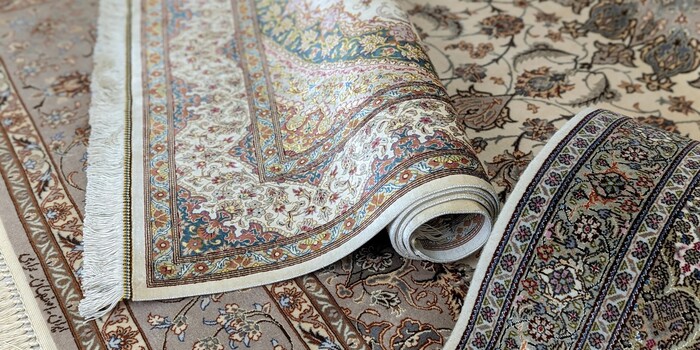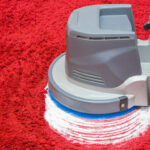If you’re looking to buy a new rug to brighten up your home, add some style or make an eye-catching statement, you’ve got a huge selection of designs and options to choose from. One of the different types of rugs that you’ll probably come across during your search are Oriental rugs.
Popular, desirable, timeless and of excellent quality, it’s easy to understand why Oriental rugs are so prized and sought-after by rug connoisseurs. If you’re pondering whether to get an Oriental rug or not, here’s the lowdown on the basics.
1. Defining Oriental rugs
Oriental rugs don’t just fall into one, single category. There are lots of different styles and designs that fit under the Oriental rug umbrella.
Oriental rugs can have various colours, designs, weave and pile types, and are made in numerous different countries, often referred to as ‘the rug belt’. This covers a wide area and includes countries in North Africa, the Middle East, Asia, India and China.
Because many of the countries that make Oriental rugs have Islamic faith, the rugs are sometimes referred to as ‘Islamic carpets’ or also ‘knotted pile rugs’.
Oriental rugs enjoy a long, rich history, and their origins are said to date back to around 500 BC.
2. Are Oriental and Persian rugs the same?
There’s often a lot of confusion when talking about Oriental and Persian rugs, with many people using the terms interchangeably. However, they’re not quite the same thing. All Persian rugs can be considered Oriental rugs, but not all Oriental rugs are Persian rugs.
Persian rugs are primarily made in Persia, or what we now call Iran, so any Oriental rugs woven outside this area aren’t classed as Persian.
It’s not just Persian rugs which are identified by the region they were made in. Each specific area may have its own way of constructing the rug, and uses of certain design features or characteristics that make it unique to that particular country or region. Often the designs, colours, motifs and weaving techniques used reflect a country’s heritage or culture.
Persian rugs, for example, often feature floral patterns and very intricate designs, and are usually constructed from cotton, silk or wool. Turkish rugs tend to consist of bold colours and strong geometric shapes, and are made from durable wool. Rugs from China are known for being made from silk, with floral and dragon designs, and ornate borders.
3. How Oriental rugs are made
Typically, an Oriental rug is woven by hand, using a loom, with wefts, warps and the pile constructed of natural materials. Delicate strings of yarn are carefully knotted into the warp and weft, and often gold or silver threads are woven into the pile. The pile threads may be dyed with natural colours. After the rug has been woven, its borders may be fastened and its pile clipped to create an even surface.
Oriental rugs are made using a wide range of colours, and traditionally the colours used had various associations. For example, gold or yellow colours indicated wealth, while the use of blue hinted at nobility or a sign of virtue.
4. Identifying Oriental rugs
With Oriental rugs varying so much, it can be tricky knowing whether you’re buying a genuine Oriental rug or not. But there are a few things you can look out for. Generally, the pattern in the rug will give it away. Oriental rugs tend to have what’s referred to as a ‘medallion’. This is a type of design that consists of symmetrical patterns or shapes in the centre of the rug, and is usually repeated in the corners of the rug.
Another indicator that a rug is Oriental is usually by the shapes it has. These tend to be either geometric and floral, and can have very intricate and ornate detailing in them.
Oriental rugs also tend to have a really dense weave, making them quite heavy. This reflects their traditional use for offering good insulation on covering floors and walls.
Traditionally, Oriental rugs are also handmade, with intricate weaving and attention to detail making even identical styles of rugs possess slight variations. The craftsmanship and skill involved in making each rug reflects its high-quality and expensive price. However, with the right care, an Oriental rug can last for years, making it a worthwhile investment.
Nowadays, some Oriental rugs are constructed using machines, although many are still made by hand to help preserve the ancient traditions and craft associated with their country of origin.
5. Rug materials
Oriental rugs can be made in different ways. They can be flat-woven without a pile or pile woven. Materials used to make Oriental rugs include cotton, silk, wool, jute and even animal hair, although the durability and versatility of wool makes this one of the most common materials used to make the rugs.
Flat-woven rugs without a pile consist of horizontal and vertical yarns which form the design of the rug. Hand-knotted rugs create the rug pattern and pile using strands of yarn which are tied into the flat-woven fabrics of the weft and warp yarns.
6. Sizes and uses
From small, pillow-sized rugs to large, full-length floor coverings, Oriental rugs come in all sizes, and shapes. As well as being used as rugs, they have enjoyed various other uses over the years, including wall coverings, saddle bags, bed throws, table covers and prayer mats. As much as they’re prized for their practical use, they’re admired for their decorative attributes, with many people considering them as works of art.
7. Choosing an Oriental rug
As there’s so much choice in the Oriental rug market, it’s important to explore all of the different options fully, to make sure you pick the right one for your premises, and to maximise your investment.
Think about where the rug will be located. What size of rug will work best, and what kind of material do you want? How will the rug fit in with the existing décor of a room?
Oriental rugs make a beautiful statement, so put them in a room where they can be seen and admired. Bear in mind that genuine Oriental rugs can be fragile, and will need careful, frequent cleaning, so avoid placing them in areas of heavy footfall.
8. Caring for your Oriental rugs
Since most Oriental rugs are a costly investment, providing them with the right care is crucial to extend their longevity. Exposure to sunlight can fade the colours and designs in a rug, so avoid placing them in areas where the sun shines directly on them. Rotate the rug every few months so that wear and tear doesn’t become noticeable in one part of the rug.
To prevent the rug from slipping, place protective padding underneath it, and avoid putting heavy furniture on top of the rug, otherwise its fibres could become damaged.
Looking after your Oriental rugs and maintaining their beautiful appearance with regular cleaning will also ensure you can enjoy their presence in your property for many years.
Because of the intricate construction of an Oriental rug, and use of natural materials, it will normally require specialist cleaning, usually by hand – so don’t be tempted to clean it yourself!
Choose a reputable rug cleaning London business such as Carpet Bright UK, who has vast amounts of experience cleaning Oriental rugs, and has the knowledge and expertise to ensure this is carried out safely, carefully and using the correct cleaning techniques and methods.
Although some rug cleaners might offer to clean your Oriental rugs in-situ, it is almost always preferable to get them cleaned offsite. At our offsite rug cleaning London workshop, we have all of the specialist cleaning and rinsing equipment, as well as drying facilities, that ensure your Oriental rugs can receive the best hand cleaning services possible.
Get in touch for a free quote.







